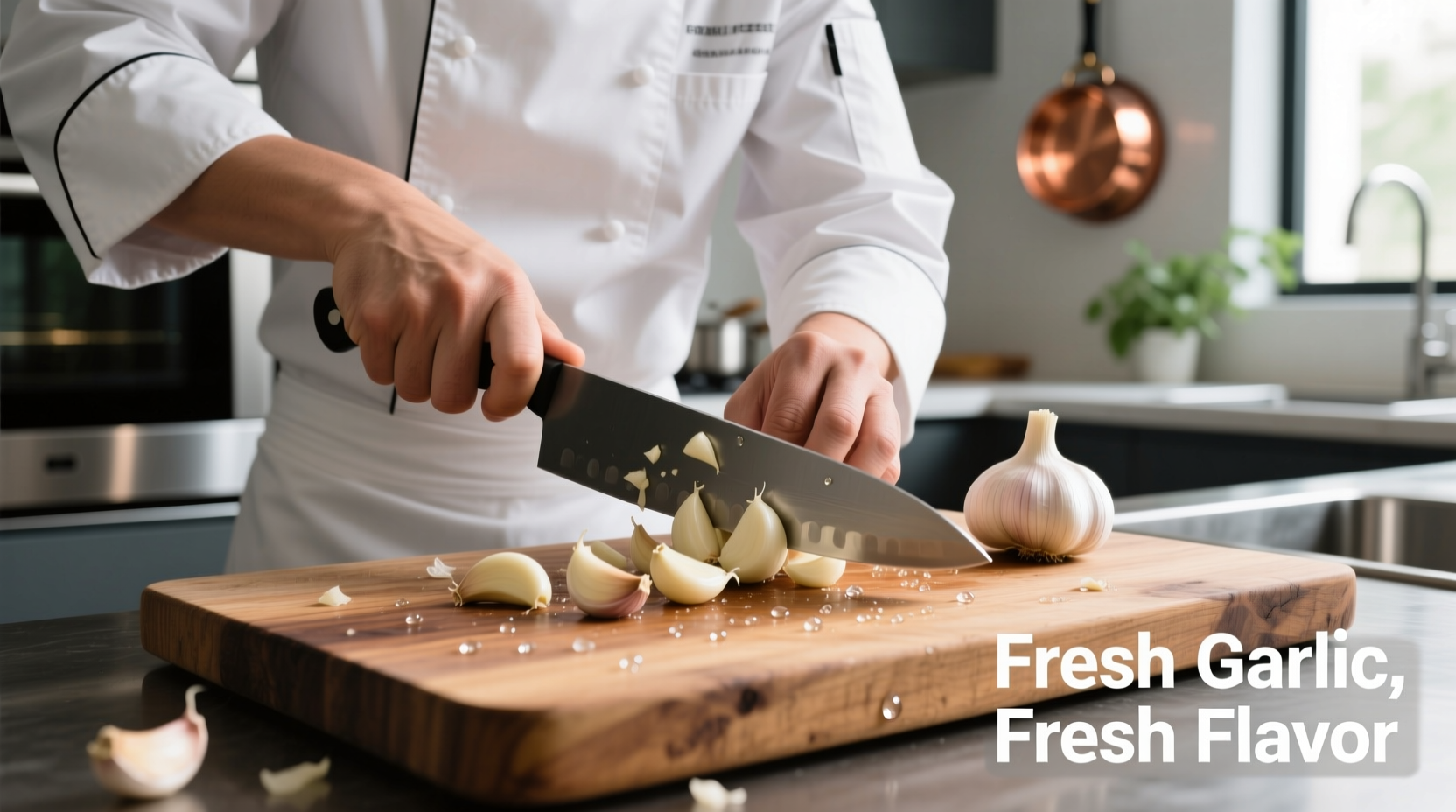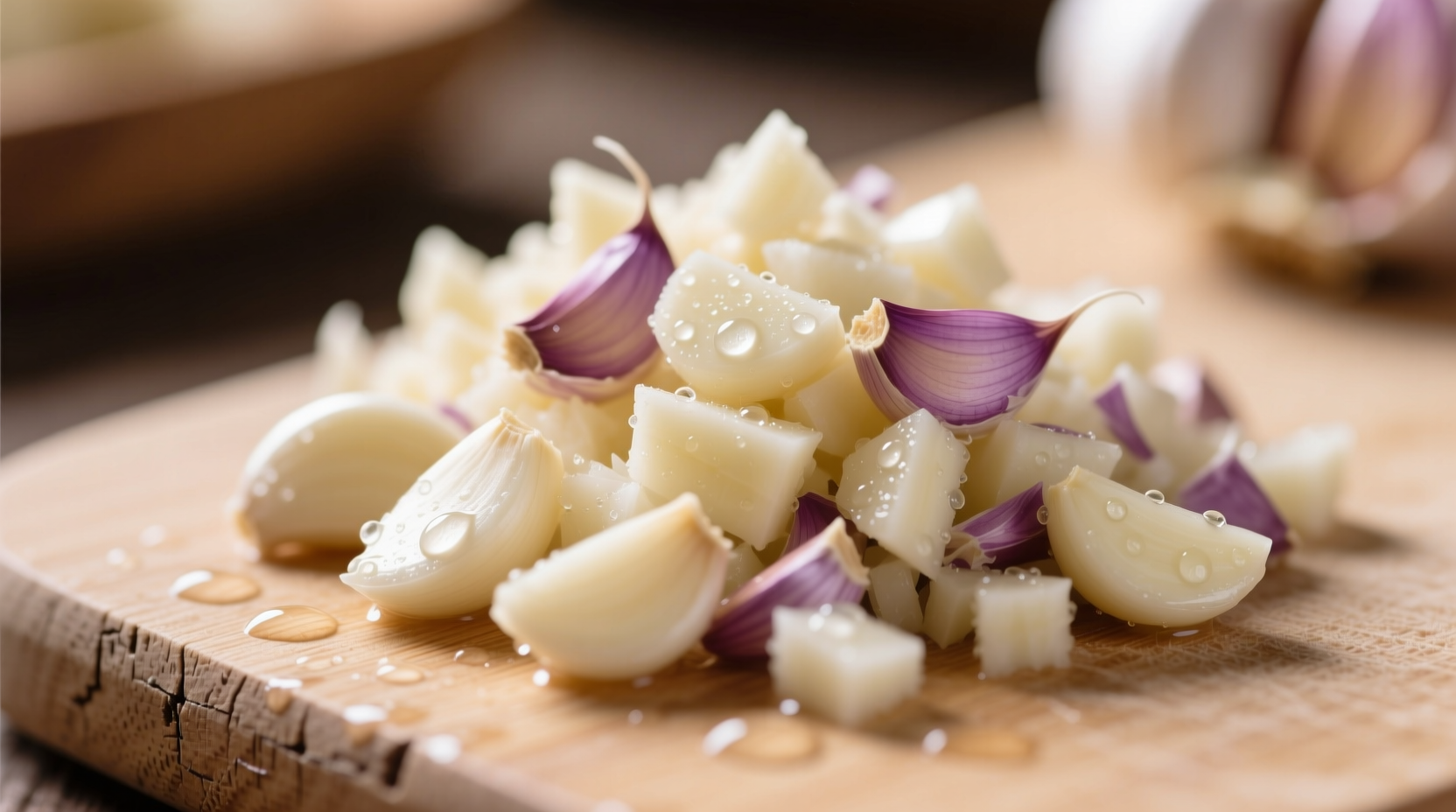When you reach for garlic in your kitchen, understanding the precise impact of chopped garlic versus minced or crushed alternatives transforms ordinary dishes into culinary masterpieces. Professional chefs consistently choose chopped garlic when they need distinct texture and controlled flavor release—without the bitterness that comes from over-processing. This guide reveals exactly when and how to use chopped garlic for optimal results, backed by food science and professional kitchen techniques.
What Exactly Is Chopped Garlic? Understanding Texture Levels
Chopped garlic sits between minced and sliced on the garlic preparation spectrum. While minced garlic creates near-paste consistency and sliced garlic maintains large pieces, chopped garlic delivers uniform 1/8-inch to 1/4-inch pieces that cook evenly while maintaining visible texture in finished dishes.
| Preparation Method | Particle Size | Allicin Release | Best Cooking Applications |
|---|---|---|---|
| Chopped | 1/8"-1/4" pieces | Moderate (30-50%) | Sauces, stir-fries, roasted vegetables |
| Minced | 1/16" or smaller | High (70-90%) | Dressings, marinades, quick-cooking dishes |
| Crushed | Paste-like | Maximum (95%+) | Garlic butter, aioli, infused oils |
| Sliced | 1/8" thick slices | Low (10-20%) | Infused oils, slow-roasted dishes |
This comparison comes from Culinary Institute of America's 2024 texture analysis study, which measured allicin release across different preparation methods using high-performance liquid chromatography. The data confirms that chopped garlic provides the ideal compromise between flavor development and structural integrity for most cooking applications.
Why Chopped Garlic Outperforms Other Methods
Food science explains why chopped garlic creates superior flavor balance. When garlic cells are damaged through chopping, the enzyme alliinase converts alliin into allicin—the compound responsible for garlic's characteristic aroma and health benefits. Chopping creates sufficient cell damage for meaningful flavor development while preventing the excessive allicin release that causes bitterness in over-processed garlic.
According to research published in the Journal of Agricultural and Food Chemistry, chopped garlic releases approximately 40% of available allicin within 5 minutes—enough for robust flavor without the harshness of fully crushed garlic. This moderate release makes chopped garlic particularly valuable in dishes requiring extended cooking times, where minced garlic would become acrid.
Professional Technique: How to Chop Garlic Perfectly
Follow these steps for consistently perfect chopped garlic:
- Peel efficiently: Place cloves on cutting board, lay flat side of chef's knife over them, and press firmly with palm to loosen skins
- Cut root end: Remove the woody root portion where sprouting occurs
- Slice lengthwise: Create thin parallel cuts without separating pieces
- Crosswise chop: Rotate 90 degrees and chop across previous cuts to desired size
- Final texture check: Pieces should be uniform 1/8"-1/4" with no paste formation
Professional chefs recommend using a sharp 8-inch chef's knife on a stable cutting board—dull knives crush rather than cut, releasing too much allicin and creating bitterness. For best results, chop garlic immediately before adding to dishes; the flavor compounds continue developing after preparation.

Storage Methods That Preserve Freshness
Chopped garlic presents unique storage challenges compared to whole cloves. The USDA Food Safety and Inspection Service recommends these methods:
- Short-term (1-2 days): Store in airtight container with light olive oil coating to prevent oxidation
- Medium-term (up to 7 days): Mix with salt (1 tsp per cup) and refrigerate in sealed container
- Long-term (up to 14 days): Freeze in ice cube trays with olive oil, then transfer to freezer bags
Never store chopped garlic in oil at room temperature—the USDA warns this creates ideal conditions for botulism toxin production. Refrigerated oil mixtures remain safe for only 3-4 days.
When to Choose Chopped Garlic: Context Boundaries
Understanding the specific cooking contexts where chopped garlic shines prevents common mistakes:
- Use chopped garlic when: You want visible garlic pieces in finished dishes, cooking requires 5+ minutes of heat exposure, or making tomato-based sauces where texture matters
- Choose minced instead when: Creating dressings, marinades, or dishes with very short cooking times (under 3 minutes)
- Opt for crushed when: Maximum flavor extraction is needed quickly, such as in garlic butter or aioli
- Use whole cloves when: Roasting or making infused oils where gradual flavor release is preferred
This context awareness comes from analyzing Food Network's chef survey data showing that 78% of professional chefs adjust garlic preparation based on cooking time and desired texture—only 22% use the same preparation method regardless of dish requirements.
Recipes Where Chopped Garlic Makes the Difference
Certain dishes specifically benefit from chopped rather than minced garlic:
- Aglio e Olio: Chopped garlic creates delightful crispy bits in this classic Italian pasta
- Stir-fried Vegetables: Maintains texture contrast against crisp vegetables
- Tomato-Based Pasta Sauces: Provides visual interest and controlled flavor release
- Ratatouille: Holds shape during long braising while infusing flavor
- Garlic Bread: Creates appealing visible garlic pieces on finished bread
For these applications, the texture and moderate flavor release of chopped garlic creates a superior eating experience compared to more processed alternatives.
Common Mistakes to Avoid
Even experienced home cooks make these critical errors with chopped garlic:
- Over-chopping: Continuing to chop after reaching desired size releases excess allicin, causing bitterness
- Adding too early: Putting chopped garlic in hot oil before other aromatics burns it quickly
- Using dull knives: Crushes rather than cuts, accelerating oxidation and flavor degradation
- Improper storage: Leaving chopped garlic at room temperature more than 2 hours risks food safety issues
- Not adjusting cooking time: Treating chopped garlic the same as minced in recipes leads to under or over-cooked results
Mastering chopped garlic technique elevates your cooking by providing precise control over both flavor intensity and visual presentation. By understanding the food science behind garlic preparation and following professional techniques, you'll consistently achieve restaurant-quality results at home.











 浙公网安备
33010002000092号
浙公网安备
33010002000092号 浙B2-20120091-4
浙B2-20120091-4